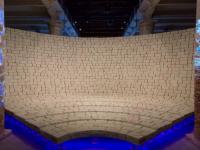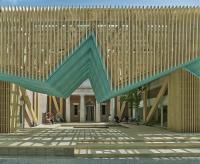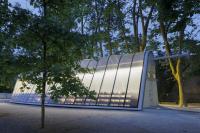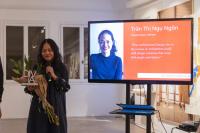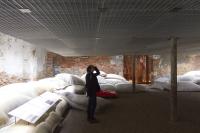Angel Building
London, Great Britain
Angel Building is the re-invention of an unloved early 1980’s commercial building located on one of London’s historic focal points where City Road and St John Street meet Pentonville Rd and bustling Islington High Street. The existing concrete frame is re-used and re-wrapped with a highly energy-efficient glazed skin which extends the building’s envelope at selective points to create a better fit with the surrounding context. An existing open courtyard is enclosed to form an internal, top-lit public room entered off St John Street which acts as the heart of the building. On St John Street a newly landscaped public realm set around existing mature trees and the introduction of shops and restaurant will bring activity to this important frontage in the heart of Islington.
The project is the latest in series of collaborations with client Derwent London which include Morelands on Old Street (home to AHMM’s offices), Tea Building in Shoreditch (where Shoreditch House hotel has a pool on the roof), Johnson Building in Hatton Garden, and Horseferry House in Westminster (HQ of fashion chain Burberry) – all of which are successful reinventions of existing buildings.
The Angel Building provided the opportunity to build on ideas and experience from these projects and take a step up in scale. The design process began with an architectural tour of New York and Chicago with Dewent London and led by AHMM where a number of the buildings provided reference points. A particular favourite, the Manufacturer’s Hannover Trust Building in New York by Gordon Bunshaft of SOM, suggested how to articulate and proportion the façade and how to deal with a corner site. Mies at Seagram inspired above all through quality of detail and at Crown Hall through the refined use of structure and volume.
An analysis of the existing building showed that whilst the cladding and services had reached the end of their life, the in-situ concrete structural frame was sound and good floor to ceiling heights generous enough to support reuse. The enormous saving in embodied energy associated with retaining the frame easily outweighed the additional technical complexities of incorporating it, and this strategy was adopted. Also an underused space in front of the building on St Johns Street allowed the footprint to be extended to create a better fit with the curve of the street. The series of mature trees on the site are retained and enhanced by a new high quality public landscaping.
A further opportunity was identified at the centre of the existing building where a large external courtyard was located, invisible from the street and largely unused. A new structure has been inserted into this space which contains cores and a generous internal atrium linked to the public space on St John Street via a new double height entrance hall. The new top floor is set back from the lower floors, significantly so at the south and west where large roof terraces are created with panoramic views over the city. Skylights are incorporated into the terraces to articulate the space and allow natural light down onto the floor below.
The new cladding for the building was tested via full scale mock-ups at the factory of the façade sub-contractor Scheldebouw in Holland. 3m wide unitised panels were selected over the usual 1.5m module to reduce the number of mullions and maximise the feeling of openness from the office floor plates. To allow people control over their environment, opening windows are included in every other bay. Low-iron glass is used throughout to maximise transparency. To control solar-gain advanced high performance coatings and frit are incorporated. The 15mm wide stripes on horizontal frit are also used to unify the new and old parts of the building structure behind.
The structure of the new atrium is formed from high-quality concrete, poured in-situ, with an as-struck finish – a brave and unusual choice for this type of building which would commonly see a more conservative overclad solution. The contrast between the rawness of the concrete and the highly engineered glazing panels are key to the experience of the space, which is enhanced by the carefully detailed ties holes and joints in the concrete which illustrate the process of construction.
Based on a 3m grid, the structural frame of the atrium is clearly legible and is articulated with a series of ‘places’ that will bring activity to all levels. At ground floor, large café and lounge areas sit on either side of the main atrium and the reception desk is built-in beneath a first floor break-out space accessed by a pair of concealed staircases. Juliet balconies outside meeting spaces open on the atrium at first floor level, and further break-out spaces are located at second and fourth floors. The grid continues at roof level to form a series of 1.8m deep cells which support the EFTE roof above and serve to diffuse direct sunlight and prevent glare reaching the office spaces.
Derwent London also commissioned a series of artists to collaborate on the project. These include graphic designer David Hillman who developed a bespoke font for the building signage, Teresita Fernandez, a New York artist whose piece forms an entire wall in the entrance hall, and Ian McChesney, an architect who has designed a unique sculpture for the main atrium space. Informed by the shape created when a spoon is lifted out of a tin of treacle, the elegantly tapered 25m high carbon fibre structure acts as a counterpoint to the concrete grid of the atrium, as well as provide a comfortable seat for guests.
At the heart of the design process was the desire to minimise energy use. Any rain water falling on the roof and terraces is collected, filtered and used to flush to toilets and irrigate the planting. Lighting is carefully controlled by daylight and motion detectors. A large bike store is provided in the secure landscaped area to the rear of the building and showering and changing rooms provided nearby. In winter, heating is provided by biomass boilers, and in summer the office space is cooled by a low energy displacement ventilation system. These efforts, along with minimising C02 produced during the construction process, mean the building is on target to achieve an ‘Excellent’ BREEAM rating.
- arkkitehdit
- Allford Hall Monaghan Morris
- Location
- 407 St. John Street, EC1V 4AB London, Great Britain
- Year
- 2010






